Private rented housing energy efficiency: consultation assessment (part one)
Partial business and regulatory impact assessment (BRIA) of our consultation on efficiency and condition standards.
1. Purpose and intended effect
This partial Business and Regulatory Impact Assessment ( BRIA) accompanies the Scottish Government consultation on minimum standards of energy efficiency in private rented sector housing.
The consultation proposes a minimum energy efficiency standard for homes in the private rented sector. From 1 April 2019, private rented properties will need to have an EPC rating of at least E at the point of rental (or have had an assessment done before rental and be improved within 6 months), and by a backstop date of 31 March 2022, all private rented properties will need to meet this standard. The consultation further seeks views on a trajectory which would see the standard increased over time; in particular, from 1 April 2022 the minimum standard at point of rental would be raised to a D, and all properties would need to have an EPC of at least D by 31 March 2025.
This document provides an assessment of the impact of the proposed regulation on various parties and sectors within the Scottish economy. The analysis and data provided will also help readers to assess the impact of varying the parameters of the regulation, which will help them in responding to the questions posed in the consultation document about the design of the regulations.
1.1 Context
The Scottish Government seeks to improve the energy efficiency of the Scottish housing stock. Minimum energy efficiency standards in the private rented sector support Scottish Government efforts to meet its climate change, energy efficiency and fuel poverty targets.
Furthermore, improvements in the energy efficiency in houses will help the Scottish Government to achieve broader objectives, which include supporting economic growth and jobs in the green construction industry and improving public health. In particular, it will support the following National Outcomes: [1]
- We live in well-designed, sustainable places where we are able to access the amenities and services we need.
- We reduce the local and global environmental impact of our consumption and production.
1.1.1 Climate Change targets
The Climate Change (Scotland) Act 2009 sets a target of an 80% reduction in greenhouse gas emissions on 1990 levels by 2050. Emissions from the residential sector represented 12.6% of total direct emissions in 2014. [2] Residential emissions have fallen by 26% between 1990 and 2014, although they can vary significantly from year to year as a result of fluctuating external temperatures.
The Scottish Government published its draft Climate Change Plan on 19 January 2017, setting out policies and proposals to reduce emissions during the period 2017-2032. [3] Reducing carbon emissions in the residential sector is one of the most cost-effective ways to reduce greenhouse gas emissions, and the draft Plan proposes that emissions in the residential sector, which are principally derived from space and water heating, be reduced by 75% in 2032 against 2014 levels.
1.1.2 Energy Efficiency targets
The Scottish Government published "Conserve and Save: The Energy Efficiency Action Plan for Scotland", in October 2010. [4] This set a target of a 12% reduction in final energy consumption across all sectors by 2020, as against a baseline averaged over the years 2005-2007. In 2014, final energy consumption was 15.2% lower than the 2005-2007 baseline. [5]
The Scottish Energy Strategy is currently out for consultation, asking for views on a variety of issues, including what targets for energy efficiency and renewable energy should be set out to 2030. [6]
1.1.3 Fuel poverty targets
In the Housing (Scotland) Act 2001, the Scottish Parliament set out the fuel poverty definition, as well as a requirement for a Fuel Poverty Statement to be made every four years to describe measures taken and progress made in tackling fuel poverty. The 2002 Fuel Poverty Statement set the following target: "The Scottish Government aims to ensure that by November 2016, so far as is reasonably practicable, people are not living in fuel poverty in Scotland." The Minister for Local Government and Housing advised Parliament in June 2016 that this would not be achieved by November 2016. [7]
A household is currently defined as being in fuel poverty if, to maintain a satisfactory heating regime, it would be required to spend more than 10% of its income on all household fuel use. However, we have accepted the recommendation from the short-life Fuel Poverty Strategic Working Group to review this definition as they believe that it may be unhelpful in targeting support at those who need it most. [8] We have commissioned an independent review of the fuel poverty definition, to ensure we are setting the correct policy objectives, and have the correct basis for targeting resources and measuring progress. We expect this review to be completed by late summer 2017. We will then consult on a new fuel poverty strategy, including a new fuel poverty target, before the end of 2017.
Under the current definition, fuel poverty is determined by the energy demand for heat, household income and energy prices, although this may change as a result of the forthcoming review. Fuel poverty is distinct from income poverty in that, while low income is an important driver, it is not a prerequisite. Improving thermal efficiency of domestic properties addresses one of the key variables behind fuel poverty, reducing the energy demand for heat.
Fuel poverty rates are monitored through the Scottish House Condition Survey. The latest data indicates that an estimated 748,000 households (30.7% of all households) were in fuel poverty in 2015. This is almost 100,000 fewer households than in 2014, when 845,000 households (34.9%) were in fuel poverty. However, Figure 1 illustrates that this recent moderation in fuel poverty rates is in the context of a longer-term increase, the result of large increases in fuel prices which have more than offset improvements in energy efficiency and household incomes.
Figure 1. Fuel poverty in Scotland, 2003/4 to 2015
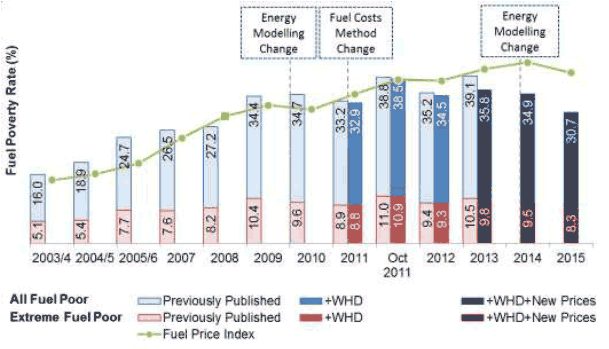
Source: Scottish House Condition Survey, 2015
As Figure 2 shows, the energy efficiency of their dwelling is strongly correlated with whether or not households are in fuel poverty. Thus, improvements to energy efficiency as a result of the proposed regulations can play an important role in mitigating fuel poverty in private rented properties.
Figure 2. Fuel poverty rate in all tenures, broken down by EPC band of dwelling, 2015
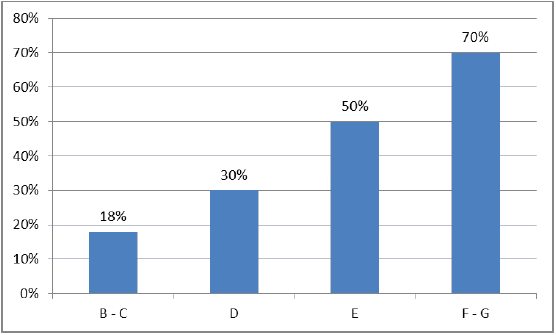
Source: Scottish House Condition Survey, 2015
1.1.4 Scotland's Energy Efficiency Programme ( SEEP)
The Scottish Government has designated energy efficiency as a National Infrastructure Priority, and the primary delivery vehicle will be Scotland's Energy Efficiency Programme ( SEEP). This is a long-term programme to improve the energy efficiency and reduce the environmental impact of Scotland's buildings in the residential, services and industrial sectors. It will build on our existing successful delivery programmes and include the development of a package of actions, spanning regulations and standards, financial incentives, advice and information, and delivery programmes. It is currently out for consultation on options for programme and policy design. [9] This consultation on minimum energy efficiency standards in the private rented sector forms part of SEEP.
1.2 Policy objectives
The private rented sector has grown significantly in recent years, rising as a share of the Scottish residential sector from 6% in 2003 to 14% in 2015. It has become increasingly important as a housing option for people at different points in their lifetimes, and not just for young, single people: for example, around a quarter of privately renting households have children. [10] It is crucial that tenants in the private rented sector have good-quality, energy-efficient homes and that landlords have a fair and workable market framework for them to be able to continue to maintain and expand the sector.
The Scottish Government's strategy for the private rented sector, "A Place to Stay, A Place to Call Home", [11] sets out a vision for "a private rented sector that provides good-quality homes and high management standards, inspires consumer confidence, and encourages growth through attracting increased investment". Improving the energy efficiency of properties in the private rented sector will help to improve housing quality, which in turn will reduce the cost of heating these properties and improve tenant health and wellbeing.
In addition to improving the quality of the offer to tenants, improving energy efficiency in the private rented sector will help to achieve the climate change, energy efficiency and fuel poverty targets set out above.
1.3 Background: Energy efficiency in the Scottish residential sector
There are an estimated 2.4 million occupied dwellings in the residential sector in Scotland, 14% (around 350,000) of which belong to the private rented, 61% to the owner-occupied, and 23% to the social rented sectors. [12]
The average (mean) Energy Efficiency Rating ( EER) in the residential sector, calculated using the Standard Assessment Procedure ( SAP 2012), is 63. [13] The EER is measured on a scale of 1 to 100, with a higher score reflecting greater energy efficiency. For the purposes of Energy Performance Certificates, EER scores are divided into seven bands, labelled A to G. Band A ( EER 92 to 100) represents the highest energy performance, while band G ( EER 1 to 20) denotes the lowest energy performance. The average score of 63 for the residential sector falls into EPC band D.
While energy efficiency across the domestic sector has been improving in recent years, [14] there are important differences across sectors. The average energy efficiency rating in the private rented sector is 61, as compared to 62 for the owner-occupied and 67 for the social rented sector. There are also significant differences in the distribution of dwellings between EPC bands in the different tenures, as set out in Table 1 and illustrated in Figure 3.
Table 1. EPC Band by Tenure in 2015, SAP 2012 [15]
| EPC Band | Owner-occupied | Private rented | Social rented | All Tenures | ||||
|---|---|---|---|---|---|---|---|---|
| 000s | % | 000s | % | 000s | % | 000s | % | |
| A (92-100) | - | - | - | - | - | - | - | - |
| B (81-91) | 23 | 2% | 12 | 3% | 18 | 3% | 53 | 2% |
| C (69-80) | 460 | 31% | 103 | 30% | 274 | 46% | 837 | 34% |
| D (55-68) | 690 | 46% | 131 | 38% | 239 | 41% | 1,061 | 44% |
| E (39-54) | 258 | 17% | 65 | 19% | 45 | 8% | 368 | 15% |
| F (21-38) | 54 | 4% | 26 | 8% | 13 | 2% | 94 | 4% |
| G (1-20) | 17 | 1% | 4 | 1% | - | - | 20 | 1% |
| Total | 1,502 | 100% | 342 | 100% | 589 | 100% | 2,434 | 100% |
Figure 3. Proportion of dwellings by EPC band and tenure in 2015, SAP 2012
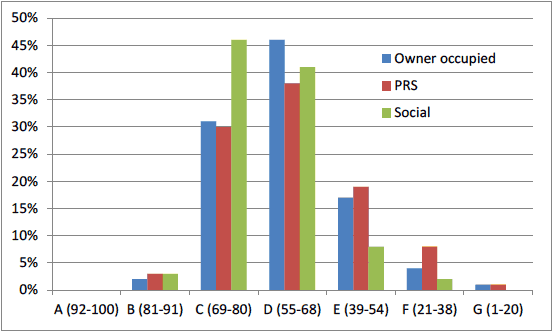
Source: Scottish House Condition Survey, 2015
In the private sector, the most common EPC band is D: 38% of private rented stock and 46% of owner-occupied stock fall into this band. In the social sector, however, band C has the largest share (46%). This relatively worse performance of the private rented sector is also reflected in the higher share of dwellings which fall into the lowest bands: 28% of private rented dwellings (95,000) fall into EPC bands E, F and G as compared with 22% (329,000) in the owner-occupied and 10% (58,000) in the social rented sector, while for the two worst EPC bands - F and G - the share is 9% (30,000 dwellings) in the private rented sector as compared with 5% (71,000 dwellings) in the owner-occupied and 2% (13,000 dwellings) in the social rented sector.
Figure 4 shows the trends in the number of dwellings in each EPC band in the private rented sector over the period 2010 to 2015.
Figure 4. Number of private rented dwellings by EPC Band, 2010 - 2015, SAP 2009 [16]
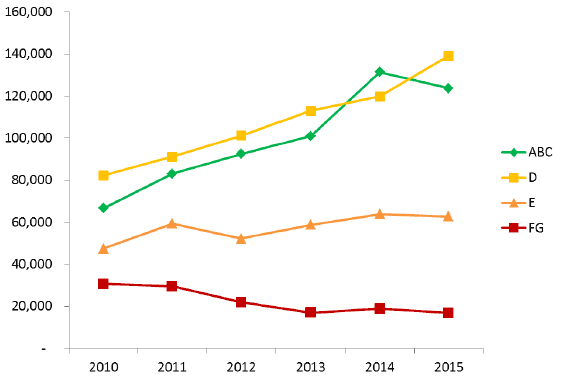
Source: Scottish House Condition Survey, 2010-2015
Since the total size of private rented sector grew over this period, Figure 5 also shows the trends in EPC bands as a proportion of all dwellings in this sector. While there was a downward trend in both the number and share of F and G-rated properties from 2010 to 2013, this has subsequently levelled off.
Figure 5. Proportion of private rented dwellings by EPC Band, 2010 - 2015, SAP 2009
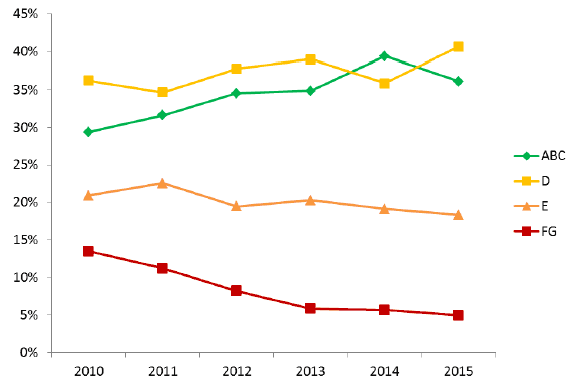
Source: Scottish House Condition Survey, 2010-2015
Figure 6 provides a similar breakdown in the trends by EPC band for the social rented sector, and illustrates the much smaller proportion of F and G-rated properties in this sector. Within this, the number of properties in the worst band, G, is minimal (see Table 1). Furthermore, Figure 6 shows that over the period 2010 to 2015 the decline in the proportion of dwellings falling into band E was much stronger in the social than in the private rented sector (compare Figure 5).
Figure 6. Proportion of social rented sector dwellings by EPC Band, 2010 - 2015, SAP 2009
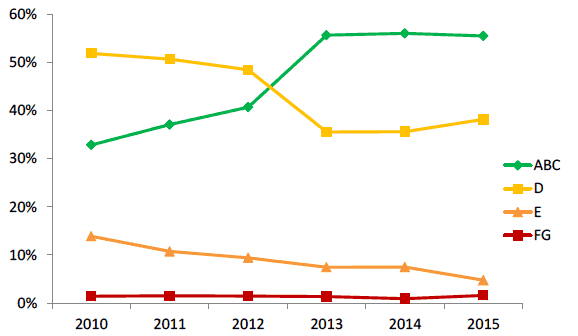
Source: Scottish House Condition Survey, 2010-2015
Key characteristics which determine the energy efficiency of a dwelling include the efficiency of its heating systems, as well as the amount of heat which is lost through exposed surfaces, which in turn is affected by the proportion of exposed surfaces, the construction form and material of its walls, windows, roof, etc. and the level of insulation that has been fitted to these surfaces. Since the Energy Efficiency Rating measures the costs of heating a property, the type of fuel used will also have an impact due to their different costs.
Differences in energy efficiency between and within sectors can therefore be partly due to the prevalence of different types of dwellings and fuel use. Figure 7 shows that the owner-occupied sector has a much greater proportion of detached houses than other sectors, while the private rented sector has a high proportion of tenements, which are typically stone dwellings.
Figure 7. Share of dwelling type in each tenure, 2015
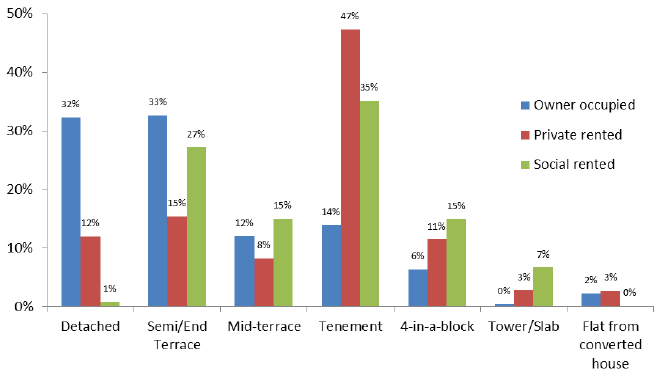
Source: Scottish House Condition Survey, 2015
Figure 8 shows that the private rented sector has a relatively smaller share of properties using gas as the primary fuel type, and a relatively larger share of dwellings using electricity, than the other sectors. The owner-occupied and private rented sectors also have a small but significant component of oil-fuelled dwellings. The social sector has the highest proportion of gas and lowest proportion of electricity, as well as a negligible share of oil-fuelled dwellings.
Figure 8. Share of primary fuel in each tenure, 2015
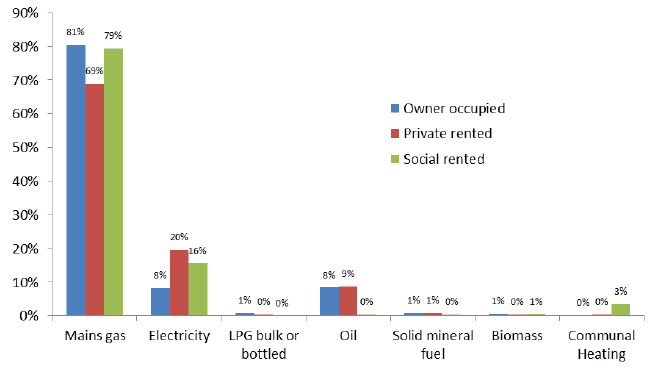
Source: Scottish House Condition Survey, 2015
Similar patterns can be found when looking at those dwellings within the private rented sector whose EPC rating falls in the lower bands. Figure 9 shows 82% of privately rented dwellings which have an EPC of F or G, and 68% of dwellings with an E, F or G, were built before 1919, as compared with 41% of all dwellings in this sector.
Figure 9. Distribution of private rented dwellings by age ( SAP 2012)
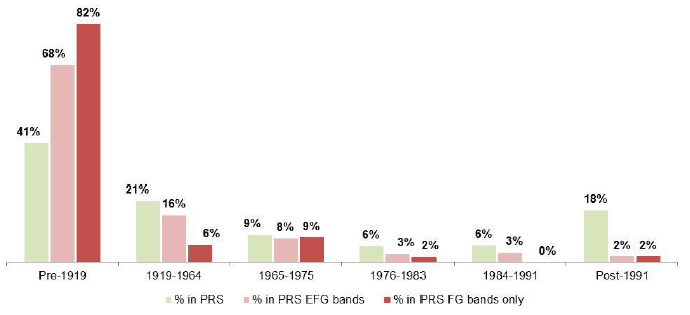
Source: Scottish House Condition Survey 2014-15
This higher proportion of older dwellings in the lower EPC bands is reflected in the wall type of properties, with 80% of dwellings in bands F and G, and 70% in bands E, F and G, having stone walls, compared with 41% of all private rented dwellings.
Figure 10. Distribution of private rented dwellings by age ( SAP 2012)
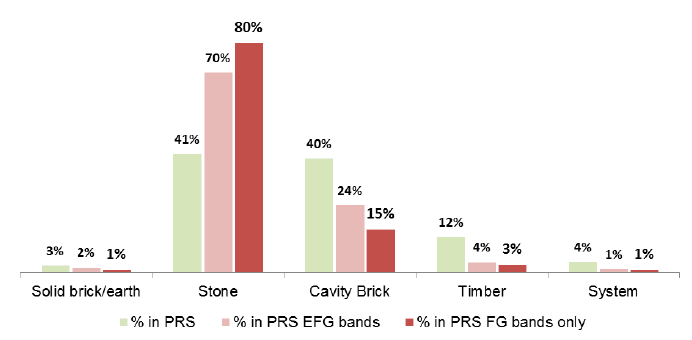
Source: Scottish House Condition Survey 2014-15
A higher proportion of private rented dwellings with low EPC ratings are situated in rural areas. Figure 11 shows that 63% of dwellings with an EPC of F or G, and 39% with an EPC of E, F or G, are located in rural areas, as compared with 15% for the sector as a whole.
Figure 11. Distribution of private rented dwellings by urban-rural location ( SAP 2012)
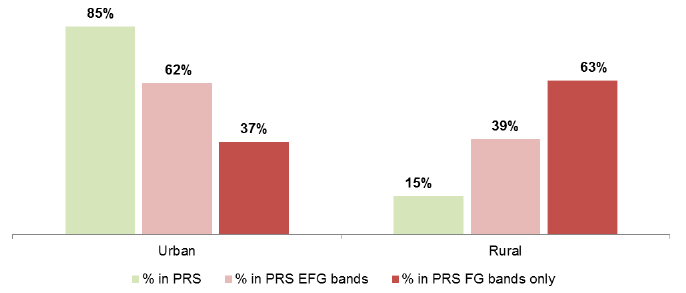
Source: Scottish House Condition Survey 2014-15
This greater rurality of the less energy efficient stock is correlated with certain key characteristics which affect the energy performance of buildings. The first is that rural dwellings are more likely to be detached houses and less likely to be flats, which means that they will have a proportionally greater external surface area leading to increased energy loss.
Figure 12. Distribution of private rented dwellings by dwelling type ( SAP 2012)
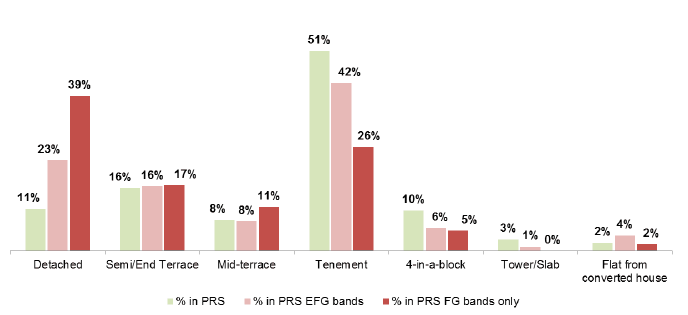
Source: Scottish House Condition Survey 2014-15
A further impact from the greater rurality of dwellings in low EPC bands is that proportionately fewer are connected to the gas grid, and therefore a greater proportion are on more expensive fuels. As illustrated by Figure 13, only 1% of dwellings with an EPC of F or G, and 37% of dwellings with an EPC of E, F or G, use mains gas, as opposed to 70% for all private rented dwellings.
Figure 13. Distribution of private rented dwellings by dwelling type ( SAP 2012)
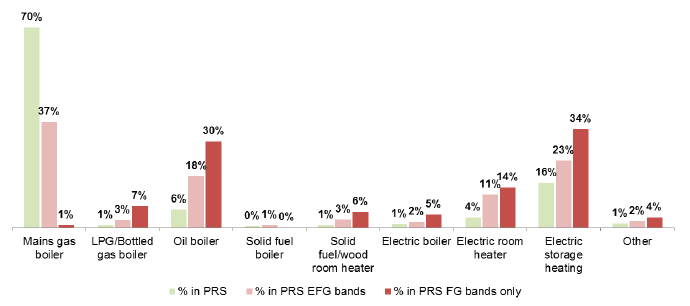
Source: Scottish House Condition Survey, 2014-15
However, it is important to note that it is not just the prevalence of different built forms that varies between sectors. In addition, the degree to which retrofit activity to improve the energy efficiency of dwellings has been undertaken varies across the sectors.
Figure 14 shows that the share of lofts which have no or low levels of insulation is higher in the private rented sector than in other tenures. The social sector has the greatest share of lofts which have been insulated to 300mm or more.
Figure 14. Insulation of loft spaces by tenure, 2015
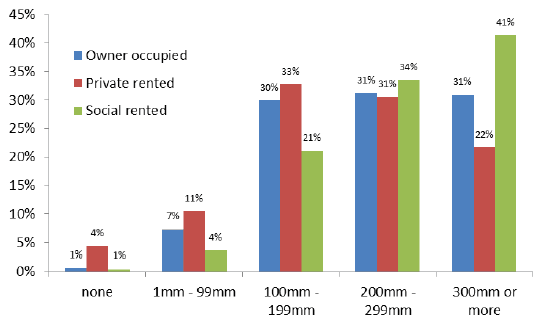
Source: Scottish House Condition Survey, 2015
Furthermore, the proportion of cavity walls which have been retrofitted is lowest in the private rented sector. Again, the highest rates of insulation are to be found in the social sector.
Figure 15. Proportion of cavity walls insulated by tenure, 2015 [17]
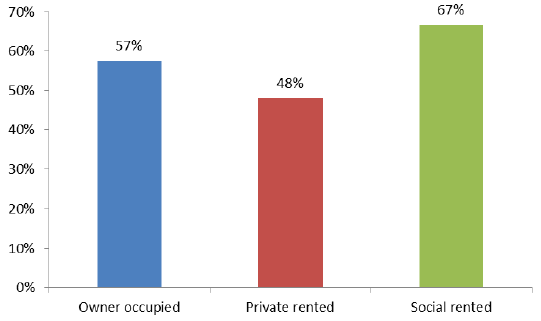
Source: Scottish House Condition Survey, 2015
The stronger regulatory framework applying to the social rented sector, with the energy efficiency elements of the Scottish Housing Quality Standard, which had to be met by 2015, now superseded by the higher requirements of the Energy Efficiency Standard for Social Housing, which sets out minimum EPC ratings to be met by 2020, is likely to have played an important role in the higher degree of retrofit activity in this sector.
1.4 Rationale for government intervention
This section considers why the presence of market failure means that government intervention can help improve the functioning of the private rented sector with respect to energy efficiency upgrades, with potential benefits not only for parties in the private rented sector, but also for wider society.
The first type of arguments consider various forms of market failure which mean that energy efficiency upgrades may not be installed even when the private net benefit is positive. The second type of arguments broaden the discussion to consider why market failures relating to wider factors such as greenhouse gas emissions and health mean that upgrades whose social net benefit is positive may not be installed. Distributional issues, i.e. the impact on the less well-off in society, further strengthen these arguments.
1.4.1 Misaligned incentives
In the private rented sector, landlords generally are responsible for paying for improvements to the dwelling, while tenants are responsible for fuel bills. This can result in a misalignment of incentives in relation to energy efficiency upgrades since the landlord is directly responsible for the cost while the benefits from reduced fuel bills flow directly to tenants. As a result, energy efficiency measures may not be installed even if the fuel bill savings over the lifetime of the upgrade would more than compensate for the capital costs of the upgrade.
However, the economic impact on parties is often not identical with who pays for particular items. [18] In this case, the potential misalignment of incentives from parties being responsible for different financial elements can be mitigated if the landlord is able to capture some of the benefit to the tenant from lower fuel bills by being able to charge a higher rent for a property with a higher quality. Where the expected fuel bill savings over the lifetime of an upgrade are higher than its cost, it is possible for both landlord and tenant to be better off from installing the upgrade - the landlord from being able to receive an additional rent which more than covers the cost of the upgrade, and the tenant because the increase in their rent is less than the decrease in their fuel bills, reducing their total expenditure.
However, there are a number of factors set out below, such as imperfect information relating to the impact of energy efficiency measures and the difficulty which people experience in assessing a varying stream of benefits over time, which mean that in the absence of regulation the market will fail to provide the optimal level of energy efficiency upgrades. The more difficulty tenants have in valuing the benefits of energy efficiency, the smaller the incentive that landlords have to retrofit their properties.
1.4.2 Imperfect information
The market in energy efficiency measures in the residential sector may be hampered by imperfect information about the benefits of installing measures. To some extent, these can be mitigated by the availability of standardised reports such as EPCs. However, the savings from an upgrade also depend on the way that a given household uses fuel in a particular property - the energy savings in the same dwelling will vary depending on how many people are in the household, how long they spend in the house, which rooms they prefer to heat and to what temperatures, etc. Thus, apart from the issue of whether households are able to understand EPC reports so that they take the EPC rating into account when choosing a property to rent, there is the further issue that it may not be easy for them to know on the basis on an EPC - which uses standardised occupancy and use assumptions - what their actual fuel bill will be.
This effect is compounded by relatively short tenure in the private rented sector: as evidenced in section 3.2, around half of tenancies end within two years. Thus tenants are often moving into new properties, and it may take them some time to learn what their fuel bills will be in a particular house, especially as there is significant seasonal fluctuation in fuel use.
As a result, when comparing two properties, one with a lower rent but with worse energy efficiency, and another with a higher rent but with better energy efficiency, households may focus on the more visible and certain extra rent they will have to pay for the second property, as against the less visible and more uncertain savings from lower fuel bills in the first property, even if fuel bill savings are potentially significantly larger.
1.4.3 Failures of rationality
Empirical evidence suggests that people can have particular difficulties when weighing up the impact of factors which are spread over time. In the case of the benefits of energy efficiency upgrades, adding to the complexity is that the savings can be quite different over different points of time, due to the strong seasonal pattern of fuel use. The fact that savings will also depend on future trends in fuel prices may further increase the complexity of the calculation that the household must make.
1.4.4 Economies in the installing market
The introduction of regulation can help guarantee minimum levels of demand for energy efficiency upgrades. This can give installers confidence to invest in equipment and training to meet the demand, and a larger market may also provide efficiencies through economies of scale and learning-by-doing effects. If a trajectory is set to a D, somewhere in the region of 100,000 dwellings will ultimately need to be upgraded due to regulations.
1.4.5 Securing permission from multiple owners
The introduction of regulations in the private rented sector may also make it easier to obtain agreement for the installation of energy efficiency measures which affect communal elements, where the approval of more than one owner is required. In particular, this may assist social landlords who are attempting to reach the Energy Efficiency Standard for Social Housing, although the proposed minimum EPC ratings for the private rented sector are below those for the social sector, at least in the first phase of regulation.
1.4.6 Greenhouse gas emissions
The case for regulation is further strengthened by taking into account the costs imposed on society from the greenhouse gas emissions produced by fuel use. Since the costs to society from climate change caused by greenhouse gas emissions are not fully reflected in the price of carbon-intensive fuels, the social benefits from energy efficiency upgrades are even larger than the private benefits from lower fuel bills. [19]
Furthermore, even for dwellings where due to their particular characteristics the net private payoff from upgrades may be marginal or even negative, from a social point of view the upgrades required by regulation can still have a positive net benefit once the benefits from reduced emissions are taken into account.
The analysis undertaken for the draft Climate Change Plan indicates that conservation measures in the residential sector form part of the least-cost path to society for achieving the greenhouse gas emissions reductions required by legislation.
1.4.7 Distributional impacts
The amount of energy consumed is a relatively fixed component of households' monthly spend, and accordingly expenditure on energy bills typically consumes a greater percentage of income for lower-income households than for higher-income households. This can result in these households facing a trade-off between paying for adequately heating their homes and spending on other basic goods and services.
By increasing the energy efficiency of homes and reducing fuel bills, regulation can help improve the well-being of some of the more vulnerable households in Scotland.
1.4.8 Health impacts
In the private rented sector, around 7% of households report that their heating never keeps them warm in winter and a further 20% that it only sometimes does. The corresponding rates for all Scottish households are 5% and 18%. [20]
Living in these low indoor temperatures may pose a risk to health due to the range of negative morbidity and mortality impacts associated with exposure to the cold. The 2011 Marmot Review Team report, [21] the 2012 Hills Fuel Poverty Review [22] and the 2013 Cochrane Systematic Review [23] set out the strong body of evidence linking low indoor temperatures to these poor health outcomes.
The Scottish Government recently commissioned an evidence review from Aether covering the potential wider impacts of climate change mitigation in the built environment, which was published alongside the Draft Climate Change Plan in January 2017. [24] The review highlighted the impact which a range of building fabric improvements can have upon the health of residents of the building. Notably, studies have found that "improvements in insulation can result in direct effects on winter mortality and potentially morbidity as well as indirect effects e.g. through reductions in mould growth (Wilkinson, 2009 [25] ). [26]
In addition to physical health benefits, the evidence review by Aether highlighted research showing that fabric improvements to improve energy efficiency can offer a range of mental health benefits. These mental health benefits are often related to reduced stress from a reduction in fuel bills as a result of increased energy efficiency.
These potential health benefits, both physical and mental, further support the case for regulation, particularly since market failures relating to imperfect information ( section 1.4.2) and failures of rationality ( section 1.4.3) are particularly likely to apply to a household's ability to assess these long-run health impacts. Health impacts also strengthen the arguments based on distributional impacts ( section 1.4.7) because they are most likely to be significant for vulnerable households. Finally, the costs to society resulting from greater demand for public sector services such as the NHS are analogous to the types of costs to society from greenhouse gas emissions discussed in Section 1.4.6, and offer a further argument in favour of regulation.
Contact
Email: Denise Buchanan
There is a problem
Thanks for your feedback